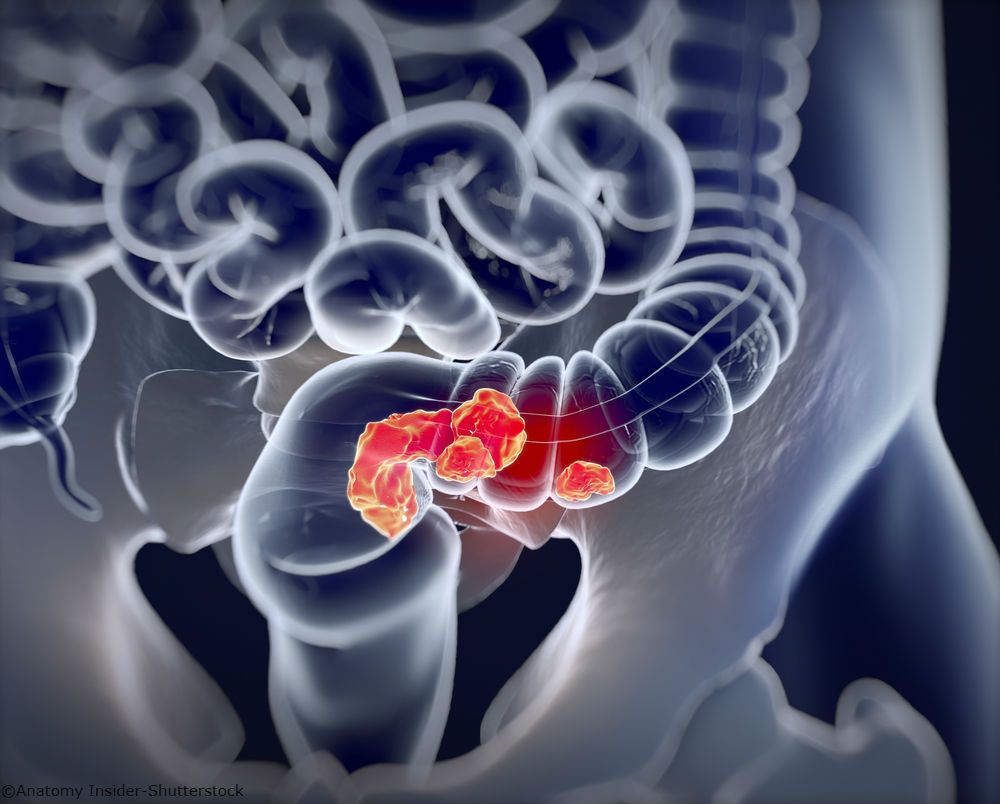Trifluridine/Tipiracil Does Not Prolong Efficacy Vs SOC in Advanced CRC
Among patients with colorectal cancer who are ineligible for intensive chemotherapy, trifluridine/tipiracil plus bevacizumab yielded similar survival outcomes compared with capecitabine plus bevacizumab.
"Trifluridine/tipiracil plus bevacizumab may be an option in patients who cannot take capecitabine. For example, patients with [dihydropyrimidine dehydrogenase] deficiency, or patients who have had bad hand-foot syndrome during adjuvant therapy with capecitabine [may be good candidates],” according to an expert from the Winship Cancer Institute at Emory University.

Trifluridine/tipiracil (Lonsurf) plus bevacizumab (Avastin) did not significantly extend overall survival (OS) but yielded a different toxicity profile compared with capecitabine (Xeloda) plus bevacizumab in the frontline treatment of patients with unresectable, metastatic colorectal cancer (CRC) ineligible for intensive chemotherapy, according to new data from the phase 3 SOLSTICE study (NCT03869892) presented at the 2023 American Society of Clinical Oncology (ASCO) Annual Meeting.1
Median OS was found to be 19.74 months (95% CI, 18.04-22.40) with the trifluridine/tipiracil regimen and 18.59 months (95% CI, 16.82-21.39) with the control regimen (hazard ratio [HR], 1.06; 90% CI, 0.90-1.25). Moreover, the 2 regimens yielded similar probabilities of survival at different time points. The experimental regimen resulted in 297 total events across 426 patients, and the comparator regimen resulted in 281 across 430.
Factors found to be significantly associated with higher OS were age under 70 years (P = .0507), location of left-sided primary disease (P = .0477), surgical resection of the primary tumor (P <.1), the number of metastatic sites (P = .0078), an absence of liver metastasis (P = .0005), a neutrophil-to-lymphocyte ratio lower than 3 (P <.1), Charlson Comorbidity Index score, and ECOG performance status.
After adjusting for the prognostic factors, investigators found no significant treatment effect (HR, 1.08; 95% CI, 0.92-1.28), thus mirroring the primary OS analysis.
The most frequent severe adverse effect (AE) was neutropenia, which affected 54% of those treated with trifluridine/tipiracil vs 1% of those treated with capecitabine. Other AEs included a decreased neutrophil count (19% vs 1%), anemia (16% vs 4%), hand-foot syndrome (0% vs 15%), and hypertension (9% vs 11%), respectively.
“Based on [these findings], capecitabine/bevacizumab is still the standard in this population in the frontline setting,” Bassel El-Rayes, MD, said during a poster session on these and other findings. “Trifluridine/tipiracil plus bevacizumab may be an option in patients who cannot take capecitabine. For example, patients with [dihydropyrimidine dehydrogenase] deficiency, or patients who have had bad hand-foot syndrome during adjuvant therapy with capecitabine [may be good candidates].”
El-Rayes is a professor, medical oncologist, and the Associate Director for Clinical Research at the Winship Cancer Institute at Emory University. He is also deputy director of the O’Neal Comprehensive Cancer Center at the University of Alabama at Birmingham (UAB).
Between March 2019 and September 2020, 856 patients were randomly assigned to either the experimental arm (n = 426) or the control arm (n = 430). Patients were stratified according to ECOG performance status, tumor localization, and whether they were deemed ineligible for intensive therapy due to a clinical or non-clinical condition.
Patients in the experimental arm received oral trifluridine/tipiracil at a dose of 35 mg/m2 twice a day on days 1 to 5 and 8 to 12 plus bevacizumab at a dose of 5 mg/kg on days 1 and 15, during each 28-day treatment cycle.
Oral capecitabine was given at 1000 mg/m2 or 1250 mg/m2 twice daily on each of the first 14 days of each treatment cycle, which was repeated every 3 weeks. Bevacizumab was given at 7.5 mg/kg to be administered on the first day of each 3-week treatment cycle.
The primary end point was investigator-assessed progression-free survival (PFS) based on RECIST 1.1 criteria. The key secondary end point was OS, and other secondary end points included the overall response rate, the disease control rate, quality of life, and safety.
A previous report indicated that the trial had missed its primary end point, with trifluridine/tipiracil yielding a median PFS of 9.4 months (95% CI, 9.1-10.9) vs 9.3 months (95% CI, 8.9-9.8) with capecitabine (HR, 0.87; 95% CI, 0.75-1.02).2
“We need more trials for these patients who are ineligible for intensive therapy,” El-Rayes concluded. “These patients are real, they exist in our clinics, and they’re understudied.”
References
- Andre T, Falcone A, Shparyk YV, et al. Overall survival results for trifluridine/tipiracil plus bevacizumab vs capecitabine plus bevacizumab: results from the phase 3 SOLSTICE study. J Clin Oncol. 2023;41(suppl 16):3512.
- André T, Falcone A, Shparyk Y, et al. Trifluridine-tipiracil plus bevacizumab versus capecitabine plus bevacizumab as first-line treatment for patients with metastatic colorectal cancer ineligible for intensive therapy (SOLSTICE): a randomised, open-label phase 3 study. Lancet Gastroenterol Hepatol. 2023;8(2):133-144. doi:10.1016/S2468-1253(22)00334-X